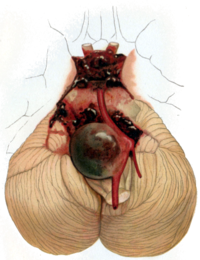
Photo from wikipedia
Renal artery embolization (RAE) was originally used only in patients with symptomatic hematuria and palliation of metastatic renal cancer. Nowadays, RAE is used for the treatment of renal medical diseases,… Click to show full abstract
Renal artery embolization (RAE) was originally used only in patients with symptomatic hematuria and palliation of metastatic renal cancer. Nowadays, RAE is used for the treatment of renal medical diseases, renal lesions such as angiomyolipoma [1,2] and vascular malformations and for preoperative reduction of vascularization of renal masses. RAE is getting more popular due to its minimally invasive nature. Various embolization agents are used in RAE; the most frequently used are metallic microcoils. Additionally polyvinyl alcohol (PVA), ethanol, gelatin sponge and trisacryl gelatin microspheres can be used as well [2]. Primary focal segmental glomerulosclerosis (PFSGS) is the cause of 20—30% of nephrotic syndrome in the adult population. It is the most common cause of idiopathic glomerular diseases and nephrotic proteinuria. More than 50% of these may progress to end-stage renal disease (ESRD) in 5—10 years
Journal Title: Diagnostic and interventional imaging
Year Published: 2017
Link to full text (if available)
Share on Social Media: Sign Up to like & get
recommendations!